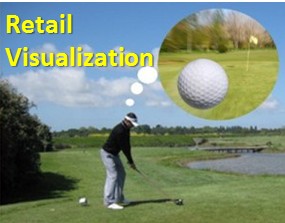"James Nesmeth...was an average golfer consistently shooting in the mid-90's, until he developed a unique way of improving his golf  game. It came while he spent seven years in North Vietnam as a prisoner of war. During those tortuous seven years, Nesmeth lived in a solitary confinement....To keep from losing all hope, he realized that he needed to do something to occupy his mind. So every day he played 18 holes of golf in his mind. He imagined everything in vivid detail...the country club...the smell of the fresh cut grass...the grip of the clubs...practice his swing many times until he perfected it....Upon returning to the actual golf course, he found that he had shaved 20 strokes off his game! By visualizing a perfect game every day for seven years he literally brought his score down to a 74." (1)
game. It came while he spent seven years in North Vietnam as a prisoner of war. During those tortuous seven years, Nesmeth lived in a solitary confinement....To keep from losing all hope, he realized that he needed to do something to occupy his mind. So every day he played 18 holes of golf in his mind. He imagined everything in vivid detail...the country club...the smell of the fresh cut grass...the grip of the clubs...practice his swing many times until he perfected it....Upon returning to the actual golf course, he found that he had shaved 20 strokes off his game! By visualizing a perfect game every day for seven years he literally brought his score down to a 74." (1)
Golf, that frustrating sport of trying to reach a target while dealing with multiple uncontrollable variables is in some ways comparable to the challenges in retail. The biggest battle in trying to conquer the game of golf is often in your mind. Successful golfers learned early in their career the simple, yet powerful art of visualization.
The future of retail will require much more intensive focus in the art of visualization. Mobile technology trends will force transformative adaptations in how consumers interact with the brick & mortar retail store. To engage shoppers new technology twists will be introduced that build on the art of retail visualization.
Making the front of the store visually pleasing has always been a key retail strategy. Many fashion and some technology brands are understandably fanatic about the store layout and making sure it does not detract from the shopper experience.
To compete in an onmichannel world, retail needs to step up its game when it comes to visualization. The brick & mortar store is not going away, but it is going to change Visualization strategies will blend the online and in-store customer experiences into a seamless journey with the focus on the brand identity.
The products that a retailer sells will still take precedence as the underlying value of the brand. Technology, however, will increase its role in how those goods are visualized and purchased by consumers. To entice an increasingly connected over-messaged shopper, the store trip needs to evolve into a multi-sensory customer experience.
The future of retail will include increased consumer interaction technology to encourage purchases. Through store provided Wi-Fi networks, shoppers will interact with the store from an onmichannel point of view. Engagement will be rewarded with coupons and offers for free shipping for goods not available in the store. Opt in services will includes games to help consumers find that special buy and / or build their loyalty points towards prizes.
Smart devices in the hands of the consumer will be tracked inside the store. These connectivity tools will increasingly interact with customer displays, fitting rooms, and the retailer's home web site on an opt-in basis. RFID will also play a key role in the interconnected store in driving item level visibility.
The importance of enhancing store visualization through technology was sparked by multiple Italian store visits this past week. The bright colors of the products, the creative artistic designs were set against stark white appealing store displays. For a moment, instead of looking at the retail products, focus shifted to the shoppers walking the store. A substantial number of shoppers, especially younger consumers were looking down at their mobile devices, responding to the last text, and probably interacting with social media. The visual eye feast of retail products available for sale was second to interacting on their electronic screen.
The store of the future will need to interact much more aggressively with those personal devices. Think of the store as the first screen and the mobile device as the second screen which can and should be an extension of the shopping experience. Consider the distractions that mobile devices bring into the retail buying process and transform the connectivity into a buying opportunity. Think of the store as an interactive technology playground to increase the value of your brand.
With technology advancements, visualizing the journey through the store of the future will get easier. It will also become more immersive and profitable.
Visualizing that golf ball reaching its target is actually a much bigger challenge.
(1) http://ow.ly/n2Hzr // Image from http://ow.ly/n1wDo
















